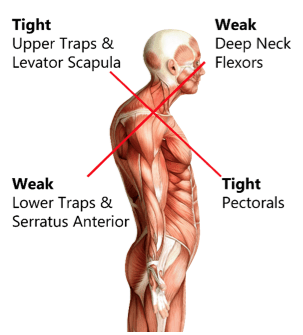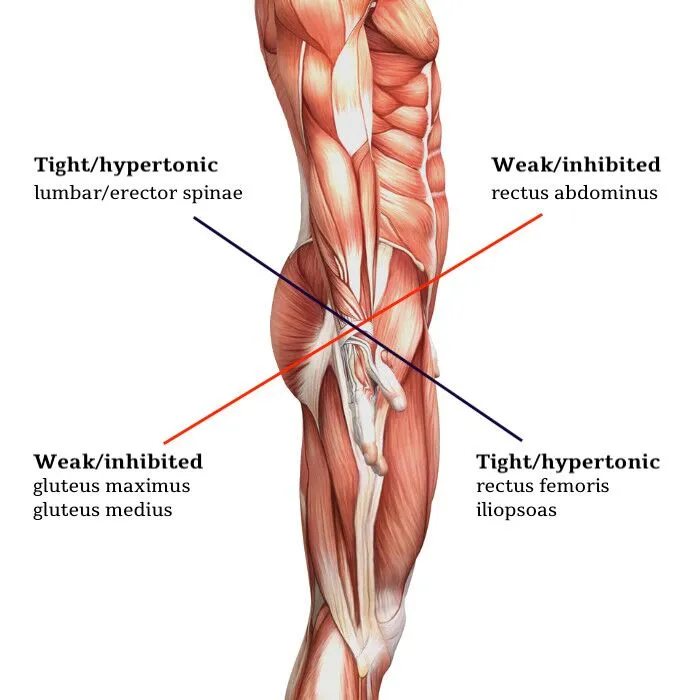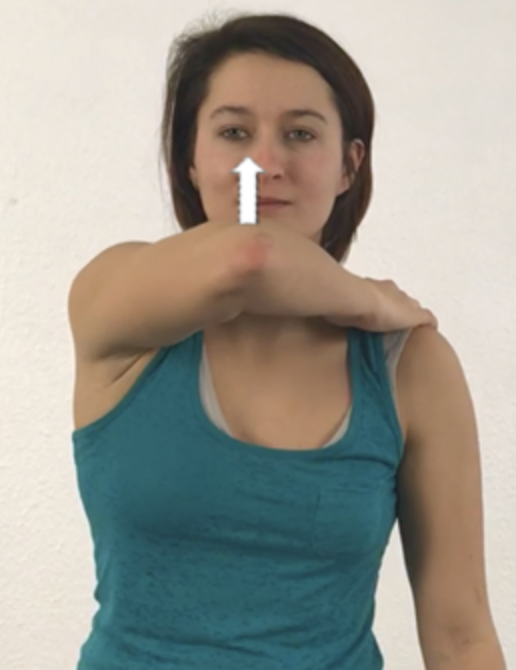MSK Basics (NPTE)
1/65
There's no tags or description
Looks like no tags are added yet.
Name | Mastery | Learn | Test | Matching | Spaced |
|---|
No study sessions yet.
66 Terms
active insufficiency
the inability of a 2 joint muscle to shortner simultaneously at both joint
→ strengthen these muscles
passive insufficiency
the inability of a 2 joint muscle to lengthen simultaneously at both joint
→ stretch these joint
Scapular upwards rotators
upper traps
serratus anterior
lower traps
→ abduction = concentric movement
scapular downward rotators
lats
pec minor
levator scapulae
rhomboids
→ adduction = concentric movement
scapular protractors
Pectoralis major & minor
Serratus Anterior
scapular retractors
lower & middle traps
rhomboids
tibia rotating laterally
open chain locking
tibia rotating medially
open chain unlocking
femur rotating medially
closed chain locking
femur rotating laterally
closed chain unlocking
Upper Crossed Syndrome
slouching / forward neck posture
facilitated: SCM/Pecs & upper traps/levator scap
inhibited: deep cervical flexors & low traps/serratus ant

Lower Crossed Syndrome
Pregnant posture
inhibited: abdominals & glutes min/med/max
facilitated: hip flexors & thoraco-lumbar extensors

Glide grade 1
small amplitude at beginning range
» for pain and ROM limitation
Glide grade 2
Large amplitude within range
» for pain and ROM limitation
Glide grade 3
Large amplitude up to full range limit
» for limitation
Glide grade 4
small amplitude at the limit
» for limtiation
scapular elevators
upper traps
rhomboids
levator scap
scapula depressors
pec major & minor
lower traps
lattiumus dori
Neuropraxia (Sunderland 1)
Symptoms:
pain w/o muscle wasting
weakness & numbness
affected proprioception
minutes - days recovery
segmental demyelination
action potential slowed or blocked at point— normal above and below
due to mild ischemia from nerve compression/traction
Axonotmesis (Sunderland 2 & 3)
Symptoms:
pain
muscle wasting
complete motor > sensation lost
months long recovery (1mm/day)
loss of axonal continuity but connective tissue intact
wallerian degeneration distally
result of prolonged compression/stretch causing necrosis
Neutrotmesis (Sutherland 3, 4, & 5)
Symptoms:
muscle wasting w/o pain
complete motor/sensory functions lost
surgical intervention required
complete severance of nerve fiber
disruption of connective tissue coverings
result of gunshot/stab wounds, avulsion, rupture
C-spine Capsular Pattern
side flexion = rotation
extension
GHJ Capsular Pattern
ER
Abduction
IR
ACJ Capsular Pattern
horizontal adduction
full elevation
Prox RUJ Capsular Pattern
supination = pronation
Thumb Capsular Pattern
abduction
extension
T-spine Capsular Pattern
side flexion = rotation
extension
L-spine Capsular Pattern
side flexion = rotation
extension
Hip Capsular Pattern
flexion
abduction
IR
Upper Trap Stretch
rotate towards, side bend opp, flex
Levator Scap Stretch
side bend opp, rotate opp (down)
Scalene Stretch
extend, side bend opp, rotate towards (up)
SCM Stretch
side bend opp, rotate towards (up)
ULTT1
Median Nerve (C5-7)
shoulder abd (~110)
elbow ext
forearm sup
wrist & fingers ext
neck bent away
ULTT2
Median, Musculocutaneous, Axillary Nerves
shoulder abd (~10), ER
elbow ext
forearm supination
wrist & fingers ext
neck bent away
ULTT3
Radial Nerve
shoulder IR, abd (~40), ext (~25)
wlbow ext
forearm pronated
wrist & fingers flex
neck bent away
ULTT4
Ulnar Nerve (C8-T1)
shoulder abd, ER
elbow flex
wrist & finger extension
neck bent away
Adhesive Capsulitis Stage 1
0-3 months
achey shoulder at rest, pain at night when laying on it, sharp pain at end ROM
pain increases with movement
some loss of ER & Abd ROM
Adhesive Capsulitis Stage 2 (Painful/Freezing Stage)
3-9 months
progressive loss of ROM and persistence of pain
loss of ROM in all planes
ER > Abd > IR
thickening of capsule
very painful
Adhesive Capsulitis Stage 3 (Frozen Stage)
9-15 months
significant loss of ROM
painful stiffening of shoulder (only with movements)
atrophy of rotator cuff, biceps, deltoid, triceps
poor scapulohumeral rhythm → scapular hike
should be 2:1 GHJ to scap, but it’s reversed
loss of axillary fold
Adhesive Capsulitis Stage 4 (Thawing Stage)
15-24 months
pain lessens but stiffness persists
slow & steady recovery
Saturday Night (Crutch) Palsy
axilla injury → very high nerve palsy
MOTOR
loss of elbow extension
wrist and digit extension loss
weak supination
SENSORY
paraesthesia posterior lateral arm, forearm, wrist, posterior aspect of thumb and radial 2.5 fingers
High Radial Nerve Injury
humerus spiral groove or shaft fracture
MOTOR
triceps spared!!
wrist drop & thumb extension weakness
SENSORY
posterior arm spared!!
paraesthesia posterior lateral arm, forearm, wrist, posterior aspect of thumb and radial 2.5 fingers
Radial Tunnel Syndrome
compression of PIN in the radial tunnel (near the supinator)
overuse injury
NO motor or sensory weakness!!!
pain ~5cm distal to lateral epicondyle
mimics lateral epicondylitis
pain on radial aspect of forearm
aggravated by resisted supination
finger extension w elbow extension (like lateral epicondylitis)
forearm pronation and wrist flexion
Posterior Interosseous Nerve Syndrome
compression of PIN between two heads of the supinator muscle
pure MOTOR nerve
pain in deep forearm and lateral elbow
weakness of wrist extensors
dropped fingers and thumb
ECRL function preserved → wrist ext and radial deviation can occur (but are probably weak)
Wartenberg Syndrome
Cheiralgia Paresthetica— compression of superficial sensory branch under ECRL and brachioradialis
trauma/tight watch/handcuffs
pain or sensory disturbances on radial side of dorsum of hand + first 3.5 digits
reproduced with flexion and ulnar deviation
NO MOTOR LOSS
tinel’s sign +ve at compression site
Adhesive Capsulitis Treatment
corticosteroid injections
stretching determined by irritability
joint mobilizations → posterior +/- inferior glide!!!!
breaks adhesions in capsule
Stage 1 or 2: grade I or II (bc they’re in pain)
Stage 3 or 4: grade III or IV (to improve ROM)
manipulation under anaesthesia
US, E-stim
should not be the first line of treatment
patient education
Anterior Shoulder Instability
most common
abduction, ER, extension
load & shift test
anterior apprehension test
Treatment:
posterior capsule stretching
stability exercises for scapula & rotator cuff
avoid chest press, pull down, push ups early on
AVOID GLIDES!
Posterior Shoulder Instability
rare presentation
from fall or pushing something heavy
flexion, IR, horizontal adduction
posterior apprehension test
jerk or kim test
Treatment:
stability exercises
avoid push ups and weight bearing early on
AVOID GLIDES!
Inferior Shoulder Instability
very rare presentation
CVA
carrying heavy handbag/objects
sulcus sign
Treatment:
stability exercises
avoid weighted shrugs/elbow curls
AVOID GLIDES!
External Rotation Lag Sign
infraspinatus
supraspinatus
Hornblower’s Test
teres minor
Empty Can Test
supraspinatus
Neer’s Test
impingement
Yocum Test
impingement
arm to opposite shoulder, elbow up

Painful Arc
60-120 → impingement of GHJ
170-180 → AC joint
Sever’s Disease
heel pain caused by swelling and irritation at growth plate
tight gastroc/soleus complex & achilles
repetitive stress activities
running, jumping, dancing
recent growth spurt
common in 8-13 year olds
S&S:
limited DF
TTP over posterior-inferior heel
P inc with WB and resolves with rest
+ve squeeze test
also diagnoses achilles rupture
diagnosed with X-ray
Anterior Compartment Syndrome
pain, pallor, paraesthesia, paralysis, pulselessness
medical emergency!
fasciotomy needed
trauma to anterior lower leg → increased risk
pain or tightness in anterior lower leg
weakness of DF and toe extensors
edema
Chronic Exertional Compartment Syndrome
repetitive activities (running, jumping, dancing) causing exercise-induced swelling
no pain at rest
begins shortly after beginning activity
pain or tightness in anterior lower leg
weakness of DF and toe extensors
edema
possible numbness/tingling
Intervention:
activity modifications
strengthening
stretching
NSAIDs
Ottawa Ankle Rules
when to refer for imaging suspecting fracture:
inability to bear weight for > 4 steps
tenderness at tips of malleolus or distal 6cm
tenderness at navicular (medially) or base of 5th
Medial Scapular Winging
serratus anterior weakness
OR
long thoracic nerve palsy
Lateral Scapular Winging
upper traps & rhomboids weakness
OR
spinal accessory nerve palsy
OR
dorsal scapular nerve palsy
McKenzie Method
herniated disc exercise progression
prone with pillows under hips
prone no pillows
prone propped on elbows
prone press ups
standing
William Flexion Progression Series
treatment for spinal stenosis
posterior pelvic tilt
single knee to chest
double knee to chest
partial sit up
hamstring stretch (long sitting)
hip flexor stretch
squat
Low Back Manipulation Criteria
patient score >/= 4/5
duration of symptoms <16 days
no symptoms distal to knee
lumbar hypermobility
at least 1 hip with >35 degrees IR
fear-avoidance beliefs questionnaire <19
Low Back Traction Criteria
low back pain with radiation into buttock, posterior thigh, posterior calf
peripheralization of symptoms on extension
positive crossed SLR
signs of nerve root compression